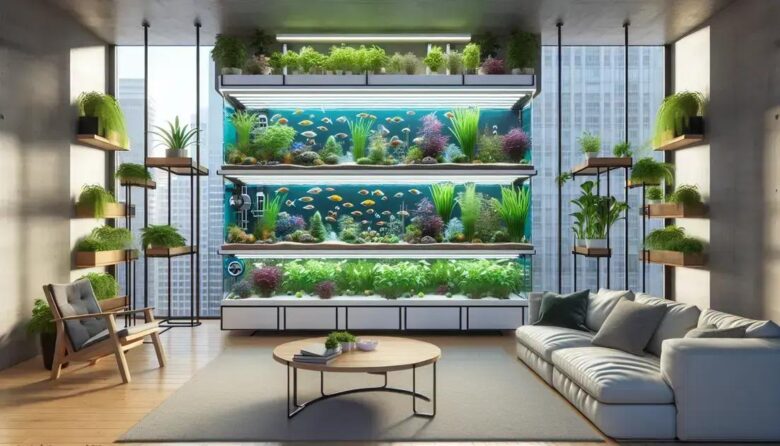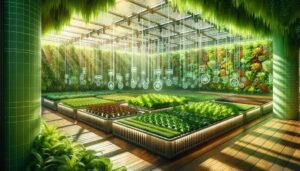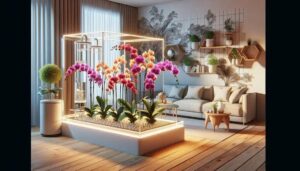Aquaponics for indoor setups in apartments is a fascinating way to grow your greens. Ever imagined turning part of your living space into a mini ecosystem? With limited space, aquaponics provides a sustainable solution that marries aquaculture with hydroponics, creating an efficient and compact gardening method. Curious about how this could work in your home?
understanding aquaponics: a sustainable solution
Aquaponics is a sustainable gardening method that combines aquaculture (raising fish) with hydroponics (growing plants in water). This reciprocal system works by using the waste produced by fish to provide nutrients for the plants, which in turn help to filter and purify the water for the fish. This creates a closed-loop ecosystem that requires less water than traditional soil gardening. Aquaponics can be particularly beneficial for individuals living in urban apartments, offering a compact and efficient way to maintain a garden indoors.
How Does Aquaponics Work?
In an aquaponic system, fish are kept in tanks where their waste accumulates in the water. This fish waste is rich in ammonia, which is broken down by beneficial bacteria into nitrates. The nitrates serve as a nutrient source for plants that are grown in water-filled beds. As plants absorb these nutrients, they clean the water, which is then cycled back to the fish tanks. This symbiotic relationship ensures both fish and plants thrive.
Key Components of an Aquaponic System
Integrating aquaponics into a small living space requires the right components. The basic setup includes a fish tank, a grow bed for plants, a water pump system, and a filtration unit. Optional items like grow lights can help optimize plant growth, especially in indoor environments with limited natural sunlight. Additionally, choosing the right type of fish and plants is crucial for achieving balance within the system.
With aquaponics, you can experience the joy of home gardening without the need for a traditional outdoor space. This innovative method allows you to grow fresh vegetables and herbs, while also sustaining a healthy aquatic life.
benefits of indoor aquaponics systems
Indoor aquaponics systems offer numerous benefits, making them an attractive option for urban dwellers with limited space. One of the primary advantages is water conservation. Traditional gardening requires a significant amount of water, while aquaponics uses only a fraction of that amount since the water is recirculated within the system. This not only conserves water but also reduces overall utility costs.
An added benefit is the ability to grow fresh produce year-round, regardless of outdoor weather conditions. This ensures a steady supply of vegetables and herbs, enhancing your diet with nutritious and pesticide-free food. Additionally, having a home-based food source can decrease reliance on store-bought produce, ultimately saving money.
Furthermore, aquaponics creates a compact and efficient system that incorporates both plant cultivation and fish farming. This synergy not only optimizes space but also promotes a balanced ecosystem where plants filter and clean the water for the fish, while fish provide essential nutrients for plant growth.
Beyond environmental and economic benefits, indoor aquaponics can also serve as an educational tool. Setting up and maintaining the system helps individuals learn about biology, chemistry, and sustainable practices, all while enjoying the therapeutic benefits of a personal indoor garden.
essential equipment for aquaponics at home
Setting up an aquaponics system at home requires a few essential pieces of equipment to ensure success. First, you need a fish tank to accommodate the aquatic life that will produce nutrients for the plants. The size of the tank will depend on the space available and the number of fish you plan to keep.
A grow bed is where your plants will thrive, using the nutrients from the fish waste. This can be made from various materials, but it must support the weight of the plants and media. You’ll also need a proper water pump to facilitate the circulation of water between the fish tank and the grow bed. This ensures a consistent flow of nutrients and keeps the system balanced.
A filtration system, such as a biofilter, is crucial to convert fish waste into nutrients for your plants. This process is vital since it keeps the water clean for the fish. Additionally, a water heater and temperature control may be needed depending on the type of fish and plants you choose. Lastly, consider incorporating grow lights if your setup is in a location with minimal natural sunlight, as they help provide the necessary light for plant growth.
step-by-step setup for your apartment
Setting up an aquaponics system in your apartment can be a rewarding project. Start by choosing the right location with adequate light and accessibility. A sunny spot near a window is ideal, but supplemental lighting may be necessary.
Begin your setup by installing the fish tank, the heart of your system, at a stable and safe spot. Ensure the tank is level and can support the water’s weight. Next, set up the grow bed above or adjacent to the fish tank, keeping in mind the need for easy water flow.
Install the water pump and connect it to cycle water between the tank and the grow bed efficiently. This system requires proper tubing and secure connections to prevent leaks. Introduce a filtration unit to help maintain clean water for your fish by converting waste nutrients for plant use.
Once installed, add the growing media to your grow bed. This material supports plant roots and helps in filtering the water. Choose lightweight materials like expanded clay pellets. Introduce plants and fill the fish tank with water, adjusting the pH to neutral levels.
Introduce fish to the system, starting with hardy species like goldfish or tilapia that thrive in aquaponic setups. Monitor the system’s balance closely for temperature, oxygen levels, and nutrient availability. This ensures your fish and plants remain healthy and productive.
Regular maintenance is key. Check equipment daily for any signs of malfunction and regularly top off the tank with fresh, dechlorinated water. Observing plant growth and fish behavior will help you catch any issues early.
maintenance tips for thriving aquaponics
Maintaining a thriving aquaponics system requires regular attention to detail. Start by monitoring water quality closely as it’s crucial for both fish and plant health. Check pH levels weekly to ensure they remain around neutral, and use water testing kits to monitor ammonia, nitrite, and nitrate levels.
Temperature control is also essential. Most fish and plants thrive in specific temperature ranges, so ensure the water temperature remains steady. Use heaters or coolers if necessary, especially if your system is subject to drastic climate changes.
Keep an eye on the pump and filtration system. Regularly check for clogs or blockages that can hinder water flow. Clean equipment as needed to prevent the build-up of debris that can disrupt the ecosystem’s balance.
Regularly trim and harvest plants to encourage new growth and prevent them from overcrowding the system. Remove any dead leaves or plants to maintain water quality. Similarly, observe your fish for any signs of stress or illness, such as unusual behavior or changes in appearance, and address issues promptly.
Top off water levels with fresh, dechlorinated water to compensate for evaporation and ensure the system continues to function efficiently. Consistent water levels help maintain nutrient balance and support overall system health.
Stay vigilant and proactive to keep your aquaponics system flourishing. This ensures a continuous supply of fresh produce and a healthy aquatic environment.
common challenges and troubleshooting
Even the most well-maintained aquaponics systems can encounter common challenges. One frequent issue is unbalanced water pH. It’s important to keep it around neutral. Regular pH testing and using safe pH adjusters can help maintain balance.
Another challenge is nutrient deficiency in plants, often noticeable through yellowing leaves. This can occur if fish waste isn’t producing enough nutrients. Consider increasing fish feed slightly or supplementing with aquaponics-safe nutrients if needed.
Fish health problems can arise if water quality is poor. Too much ammonia or nitrite can stress or even harm fish. Monitor these levels using water test kits and ensure your filtration system is working effectively. Regular water changes might be needed if issues persist.
Pest infestations, like aphids or mites, can occur in plant sections. Employ natural pest control methods, such as introducing beneficial insects or using organic deterrents, to keep your plants healthy without harming the fish.
Clogging in pipes or pump failure can disrupt the whole system. Regular inspections and cleaning help prevent blockages, while backups or alarms can alert you to equipment malfunctions.
By staying vigilant and performing regular system checks, troubleshooting common problems can become a straightforward process, ensuring a thriving aquaponics setup.
Wrapping Up Your Indoor Aquaponics Journey
Embracing aquaponics can transform your apartment into a sustainable oasis, providing fresh produce and a rewarding hobby. With the right setup and regular maintenance, you can enjoy the benefits of home-grown plants and healthy fish.
From understanding system components to troubleshooting common issues, each step is a learning opportunity. The blend of technology and nature makes aquaponics an accessible and fulfilling way to pursue gardening.
Whether you’re motivated by a desire to grow your own food or to create a small indoor ecosystem, aquaponics offers a unique combination of beauty and function. Dive into this world and explore the full potential of compact indoor farming.
Your aquaponic adventure not only contributes to sustainability but also adds a green touch to your urban lifestyle, showing that even small spaces can host thriving ecosystems.
FAQ – Common Questions About Indoor Aquaponics in Apartments
What do I need to start an aquaponics system in my apartment?
You’ll need a fish tank, grow bed, water pump, filtration system, and the right plants and fish to begin.
How much space is required for an indoor aquaponics setup?
Aquaponics setups can be designed to fit small spaces, with systems ranging from a few square feet to a full room.
Can I use any type of fish in an aquaponics system?
Common choices include tilapia, goldfish, and koi, due to their hardiness and compatibility with aquaponic environments.
What types of plants grow best in aquaponics?
Leafy greens like lettuce and herbs such as basil and mint thrive in aquaponic systems.
How often should I check the water quality?
It’s best to check water quality weekly to ensure pH, ammonia, nitrite, and nitrate levels are optimal.
Do I need special lighting for indoor aquaponics?
If natural light is limited, LED grow lights can help provide the necessary light spectrum for plants.



